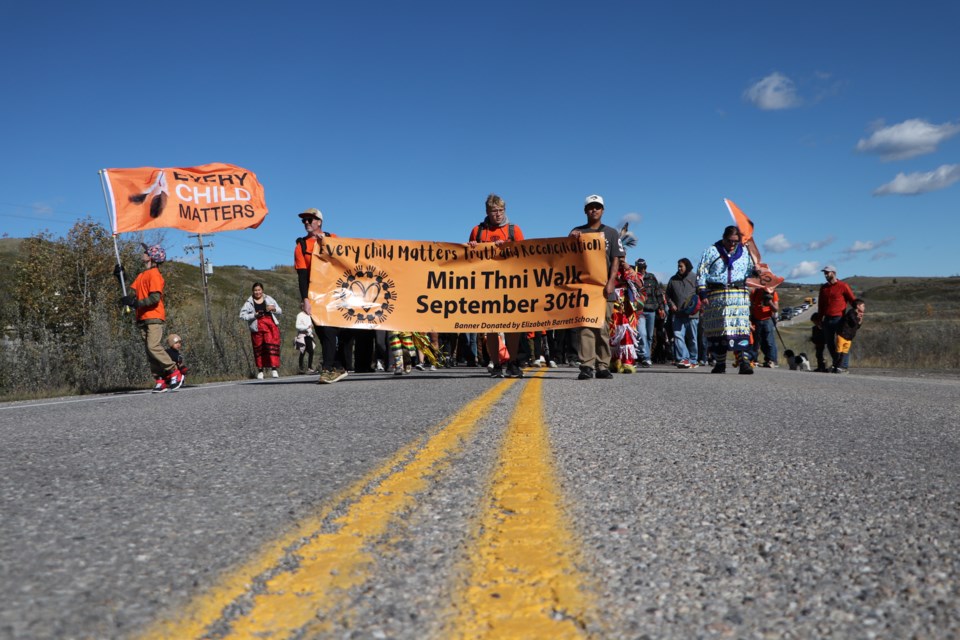ÎYÂRHE NAKODA – It was a cold and biting wind – the kind that nips at your ears and nose, even with the sun shining overhead.
But the crisp, cool air seemed apt for the fourth annual Îyârhe (Stoney) Nakoda First Nation Every Child Matters Walk – an event that is not just about the steps forward, but about reckoning with the weight of the past, the stories of lost children and generations affected by the painful legacy of residential schools.
Every year, descendant of residential school survivors and organizer of the walk, Eve Powder, is overwhelmed to see hundreds gather from neighbouring Bow Valley communities to make the three-kilometre trek together from the McDougall Memorial United Church to the Morley United Church in Mînî Thnî.
“I never expect to have a big turnout. But, for myself, I just love how it brings all our communities together,” she said.
“It warms my heart. There are no words to really describe it.”
It’s a day of reflection, with non-Indigenous and Indigenous peoples from the local First Nations community and neighbouring municipalities coming together to listen and mark the National Day for Truth and Reconciliation on Sept. 30.
Some of the stories are heavy and are left only to be told by those who have inherited the pain and resilience of their ancestors – descendants, like Powder, seeking to heal and create awareness of generational wounds that still exist.
Established in the late 19th Century and operating for over a century, residential schools were part of a government policy aimed at assimilating Indigenous children into Canadian society, a process that involved stripping children of their language, culture, and identity.
Once in the schools, children were often forbidden from speaking their Indigenous languages, practising their spiritual beliefs, or maintaining any ties to their heritage. They were subjected to harsh discipline, neglect, and in many cases, physical, emotional, and sexual abuse.
“My mom, fortunately, held onto her Stoney language and stayed fluent in it,” said Powder.
“It wasn’t until I was 13-14 years old that she told me one day ‘you’re Stoney, speak Stoney.’ From there, I started to learn my own language, but it took a while, and still, to this day, I struggle with it.”
Many residential school survivors were not as fortunate. Many left the schools without their language, their connection to culture severed, making it difficult to pass on these vital aspects of identity to their children.
For some, the trauma of their experiences is too overwhelming to recount, leading them to stay silent about what they endured.
“My mother and father went to residential school,” said Adele Rabbit, a resident of Mînî Thnî who is of Îyârhe Nakoda and Tsuut’ina descent.
“I think the hardest part for my mother was what she endured. She gets quiet about it, but she’s started to actually speak about it now – she’s 84 years old.”
Îyârhe Nakoda elder Tina Fox is also a survivor of a residential school. She attended the Morley Indian Residential School for 11 years and is outspoken about her experiences there.
Excited for her first day, her parents dropped her off in a horse-drawn wagon.
“As soon as my parents left, myself and two other girls were taken inside and stripped of our clothes,” said Fox, who at seven years old did not speak English at the time. Her excitement quickly turned to fear and regret.
A school matron proceeded to cut off Fox’s braids, replacing them with a bowl cut and straight bangs.
Fox and the other girls were soaked in kerosene and pushed into a shower. Fox had never seen a shower before and thought she was going to drown.
Her traditional dress, jacket and the brand-new brown moccasins her mother had made her were also replaced with a cotton dress and canvas shoes.
“I never saw those moccasins again,” said Fox.
The elder, like many others in attendance for the walk in Mînî Thnî, adorned an orange shirt to honour the National Day of Truth and Reconciliation, otherwise known as Orange Shirt Day.
Hers was illustrated with the moccasins taken from her and in memory of her late mother, Mary, who passed away shortly after Fox began attending residential school.
Powder emphasized stories like Fox’s, along with those wanting to engage in discussions about truth and reconciliation, should not be limited to doing so a single day each year, nor should it be an act taken up in isolation.
“If people ever want to talk about it, reflect on it … I know it can be painful and uncomfortable, but I’m here … contact me,” she said.
“I don’t mind having these conversations and, to me, it helps to share in these discussions, and I can set up meetings with elders and conversations that can help in this journey toward healing and understanding.”
The act of coming together each year to walk in unison is a powerful commitment and first step to encouraging continued dialogue and connection, Powder said.
“I take heart in seeing the support from all these communities coming together on this day,” she said.
The Local Journalism Initiative is funded by the Government of Canada. The position covers Îyârhe (Stoney) Nakoda First Nation and Kananaskis Country.




